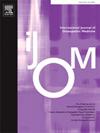Potential effects of combining osteopathic manual therapy and menstrual awareness on pain and associated symptoms in women with primary dysmenorrhea: A randomized clinical trial
IF 1.5
4区 医学
Q2 MEDICINE, GENERAL & INTERNAL
引用次数: 0
Abstract
Background
Dysmenorrhea is a menstrual condition that accounts for 50–90 % of all gynaecological consultations and is the most common gynaecological condition among young women. Lack of information regarding treatment options can affect the symptoms and quality of life of women who suffer from it. Osteopathic manual therapy could be a treatment option to improve symptoms in primary dysmenorrhea.
Objective
The aim of this study was to apply an osteopathic manual therapy protocol to reduce menstrual pain and other symptoms related to primary dysmenorrhea.
Methods
A randomized clinical trial was conducted. Thirty-nine female volunteers diagnosed with primary dysmenorrhea, with a mean age of 30.4 years (SD = 5.67), were randomly assigned to two groups: an experimental group (n = 19) who received body awareness plus osteopathic manual therapy and a comparator group (n = 20) who received only body awareness. Pain intensity (Visual Analogue Scale), pain perception (the McGill Pain Questionnaire), quality of life (36-Item Short Form Survey Instrument), body satisfaction (Body Satisfaction and Global Self-Perception Questionnaire), and overall perception of change (Patient Global Impression of Change Scale) were assessed pre- and post-treatment.
Results
Comparing both groups, the experimental group showed a statistically significant improvement in pain intensity (p = 0.007), pain perception (p = 0.025), quality of life (p < 0.001), and body satisfaction (p < 0.001). In addition, most women in the experimental group (94.7 %) perceived a positive change after treatment, while most of the comparator group (65 %) reported no changes.
Conclusion
An osteopathic manual therapy protocol combined with body awareness revealed significant improvements in terms of pain and other symptoms in women with dysmenorrhea.
结合整骨疗法和月经意识对原发性痛经女性疼痛及相关症状的潜在影响:一项随机临床试验
痛经是一种月经状况,占所有妇科咨询的50 - 90%,是年轻女性中最常见的妇科状况。缺乏关于治疗选择的信息可能会影响患有该病的妇女的症状和生活质量。整骨疗法可作为改善原发性痛经症状的一种治疗选择。目的:本研究的目的是应用整骨疗法来减轻月经疼痛和其他与原发性痛经相关的症状。方法采用随机临床试验。39名确诊为原发性痛经的女性志愿者,平均年龄30.4岁(SD = 5.67),随机分为两组:实验组(n = 19)接受身体意识加整骨疗法,对照组(n = 20)只接受身体意识疗法。治疗前后分别评估疼痛强度(视觉模拟量表)、疼痛感知(麦吉尔疼痛问卷)、生活质量(36项简短问卷)、身体满意度(身体满意度和整体自我感知问卷)和整体变化感知(患者整体变化印象量表)。结果两组比较,实验组患者疼痛强度(p = 0.007)、疼痛感觉(p = 0.025)、生活质量(p <;0.001),身体满意度(p <;0.001)。此外,实验组中的大多数女性(94.7%)认为治疗后出现了积极的变化,而大多数比较组(65%)报告没有变化。结论结合身体意识的整骨疗法可显著改善痛经患者的疼痛和其他症状。
本文章由计算机程序翻译,如有差异,请以英文原文为准。
求助全文
约1分钟内获得全文
求助全文
来源期刊
CiteScore
2.20
自引率
36.80%
发文量
42
审稿时长
3 months
期刊介绍:
The International Journal of Osteopathic Medicine is a peer-reviewed journal that provides for the publication of high quality research articles and review papers that are as broad as the many disciplines that influence and underpin the principles and practice of osteopathic medicine. Particular emphasis is given to basic science research, clinical epidemiology and health social science in relation to osteopathy and neuromusculoskeletal medicine.
The Editorial Board encourages submission of articles based on both quantitative and qualitative research designs. The Editorial Board also aims to provide a forum for discourse and debate on any aspect of osteopathy and neuromusculoskeletal medicine with the aim of critically evaluating existing practices in regard to the diagnosis, treatment and management of patients with neuromusculoskeletal disorders and somatic dysfunction. All manuscripts submitted to the IJOM are subject to a blinded review process. The categories currently available for publication include reports of original research, review papers, commentaries and articles related to clinical practice, including case reports. Further details can be found in the IJOM Instructions for Authors. Manuscripts are accepted for publication with the understanding that no substantial part has been, or will be published elsewhere.

 求助内容:
求助内容: 应助结果提醒方式:
应助结果提醒方式:


